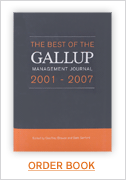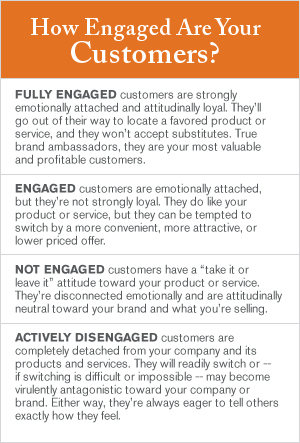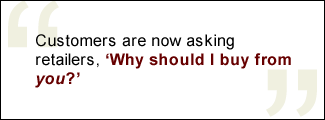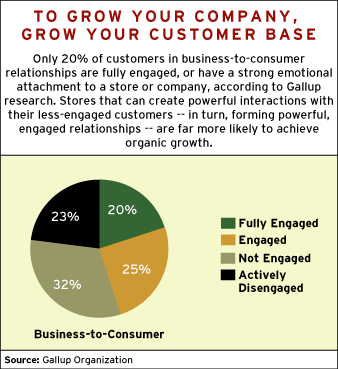There are so many measures of success for retailers today that executives must feel like they're trying to hit a moving target. The list goes on and on: same-store sales growth, average-transaction improvement, conversion lift, traffic count, gross-margin percentage, units per transaction.
 |
But according to leading retail executives, one objective overrides all the rest: creating organic growth in stores. As noted in a recent Gallup Management Journal article, "Organic growth occurs when an organization . . . creates more transactions with its current customer base and with continuously growing margins." (See "Good to Great? Or Lousy to Good?" in the "See Also" area on this page.)
Just keeping a store's current customer base happy is not enough for retailers to survive, much less thrive. The real challenge is to create customer engagement, because there's a crucially important difference between an engaged customer and a satisfied one. Fully engaged customers spend more, return more often, and are less price sensitive, and they encourage others to shop at their favorite store. In short, they're the key to building store-level organic growth. (See sidebar "How Engaged Are Your Customers?" See "Customer Satisfaction Doesn't Count" in the "See Also" area on this page.)
But given the day-to-day challenges of running a retail store, developing and growing a core base of engaged customers is a daunting task for most store managers. And the sheer number of shopping options available to customers in today's retail sector further complicates this task. Customers are now asking retailers, "Why should I buy from you?"
 |
The increasingly crowded retail landscape is just one of the factors driving the need for organic growth. Another is the speed at which products move from design through production and shipping to a store display. There is simply more competition to be the "first on the block" with the latest product. Big-box discounters have also created a downward pressure on pricing, making the sector more competitive and price sensitive. Not all retailers can -- or want to -- compete on processes and price, so many are looking for other ways to remain relevant.
Recently, Gallup hosted several of the world's leading retailers in Newport, Rhode Island, and Banff Springs, Canada, to explore their strategies for driving organic growth. These retailers represent different sectors, including consumer electronics, specialty apparel, auto parts, and home improvement; many have locations worldwide. Although these executives may define organic growth in slightly different ways, their goal remains the same: They all want more transactions with their current customer base. The question on all of their minds is: How can their businesses achieve this aim? The following four key strategies were gleaned from these conversations.
1. Build the best possible teams
Forbes magazine founder Bertie Charles Forbes said, "If you don't drive your business, you will be driven out of business." A key issue in driving business results, the executives said, is building the best possible teams at the store level. Having the right person in the right place at the right time is essential to a store's success.
Finding leaders in the field organization who know how to lead teams and manage a retail location is a challenging task. Great store managers make all the difference: Find them, and you'll succeed; lack them, and your business will flounder, the retail executives said. As in-store processes become more streamlined, retailers will need to help their managers shift from focusing on tactical and administrative elements of their job to driving results through people and product. These store managers will know how to attain results. They'll have a strong presence on the shop floor, coaching their teams to success. And they'll know how to evaluate how product is selling and maximize its placement on the sales floor.
But how will retailers find the managers of the future? The retailers Gallup spoke with are restructuring their selection criteria, seeking to hire store managers who are more strategic and think and act like business owners. These retailers also want managers who are skilled at running multiple business lines, as many are diversifying their product offerings.
The retail executives also said that selecting for talent within specific job functions is a key strategy for generating organic growth; they are looking for associates who "live" the brand and can offer a true service to their customer base. In fact, some are finding their best associates among their customer base, because they come with a built-in connection to the brand. I've observed that West Marine, a leading North American boating supply retailer, staffs its stores with boaters. Customers who are deeply involved in the boating lifestyle most likely appreciate the opportunity to buy their supplies and equipment from a true "salty dog" who can relate to them and share their experiences.
Finding the right cultural mix is also crucial. For example, Hispanics are now the largest minority population in the United States. Retailers at the summits reported that their goal is to staff their stores with a mix of ethnic and social backgrounds that mirrors that of the local population. A home-improvement retailer, for example, has identified female consumers as a growing customer segment and is making staffing its teams with women a priority.
2. Create powerful interactions between stores and customers
To drive organic growth, these retail executives are also emphasizing the customer's store experience -- carefully considering everything from the brand offerings in the store to service standards and how they are being executed to personalizing interactions between associates and customers. Customer satisfaction is not enough; a deeper understanding of what inspires a customer to be loyal is necessary for organic growth.
Clothing retailers, for example, understand that customers can buy a shirt anywhere. What customers may really crave when hunting for that shirt is a unique shopping experience. Retailers who can present their product offerings in a unique and compelling way have a distinct advantage in this environment.
In my view, H&M, the European "faster fashion" retailer, has set the tone for affordable fashion. While its price points are similar to other moderate fashion houses, H&M's assortment and store setup is not. H&M's club-style music, displays, and product mix all speak to a younger, more urban customer. That customer wants to look relevant and current and doesn't necessarily want to buy shirts at a discount. What's more important is buying what's "in," and I've observed that H&M presents its products with authority to that customer.
Another key factor in the customer's store experience is creating a trusted and sincere interaction between the customer and the store's associates. To achieve this, retailers are rethinking service standards and measures. Standards are shifting from a traditional "zone selling" approach -- in which sales associates cannot leave their assigned section of the store -- to "cross-selling," a model that frees associates to walk the store with a customer. Cross-selling creates a more intimate interaction that gives customers a sense that someone personally cares about meeting their needs. The aim is to inspire an emotional attachment to the store -- and repeat business from the customer.
3. Transform the transaction
As the retail landscape shifts, organizations must adjust their offerings and value proposition, executives said. This proposition can come in the form of education, installation, or in-store processes. It's not enough, for instance, to sell a home entertainment system; retailers must also add value by teaching customers how to use its features or helping them install it. These value-added services establish the retailer as an expert that offers customers more than products.
The goal of this strategy is to build out business. One organization noted that more than 60% of its revenue growth will come from selling more to current customers. That growth can only be achieved by providing outstanding customer service and a compelling service offering.
 |
Both home improvement and consumer electronics businesses are capitalizing on the "do it for me" movement by expanding related service offerings; some are launching or expanding divisions dedicated to this strategy. Best Buy has been aggressively marketing its "Geek Squad," a team of associates who go to customers' homes or businesses to handle any and all computer-related issues, whether or not the equipment was purchased at Best Buy. The Geek Squad not only gives Best Buy another customer "touchpoint," but I think it also helps position Best Buy as an authority on consumer electronics -- and a retailer that offers a strong value proposition to its customers.
4. Emphasize metrics that matter
The process of setting clear goals and objectives, then holding stores accountable for those goals, is a crucial factor in organic growth, the executives said. Simply stating a company goal is not enough to create a cascading effect through the field organization or to guarantee success. What's needed, they said, is a stronger focus on metrics that matter, such as conversion, average transaction, or sales per hour. Too often, stores are inundated with competing messages, such as "Grow your average transaction," "Gross margin is what matters," and "Comparable store increase is the goal." While all these messages are important, the end result is confusion, not growth.
The retailers at the summits, in contrast, said that their goal is to identify clear drivers of success. These drivers varied from retailer to retailer, but the approach was the same: They're sifting through their measurements to determine which metrics matter. Then they're communicating the importance of those metrics to store employees and managers by coaching them on how to help the company meet its goals and assessing associate and store performance against their key metrics, then rewarding associates and managers accordingly.
 |
The executives said that every sales day offers an opportunity for store managers to set clear objectives. The right "launch" to the day helps associates achieve desired results. A positive focused message on service standards and daily goals is enormously helpful in setting up a team for success and can pay big dividends for a retailer.
Getting employees and customers engaged
Gallup research has shown that on average, only 20% of customers in business-to-consumer relationships are fully engaged, or have a strong emotional attachment to a store or company. This poses quite a challenge to retailers -- but it's also a significant opportunity. Poor service, messy stores, and lackluster in-store displays won't engage customers -- and they won't help boost organic growth. Developing the best possible teams, creating powerful interactions between stores and customers, adding value beyond the transaction, and emphasizing the right metrics, in contrast, are the keys promoting organic growth from the field level on up.